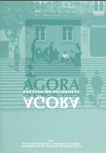Deleuze y la onto-topología de la expresión: el pliegue como movimiento fundamental de la filosofía de la diferencia
Contenido principal del artículo
Resumen
Este artículo presenta una interpretación de la ontología desarrollada por Deleuze en Différence et répétition (1968) en clave topológica. Para eso, se argumenta que las tesis deleuzianas relativas al Ser como unívoco y diferencial se apoyan en una teoría de la expresión que supone una concepción de la espacialidad que rebasa la euclidiana. El detalle de esta dinámica espacial es abordado mediante una serie de nociones matemáticas que asisten la producción deleuziana de sus conceptos ontológicos principales, definiendo la expresión y sus momentos a partir de la interacción entre distintos tipos de multiplicidades habitadas por pliegues heterogéneos.
Palabras clave:
Detalles del artículo
Referencias
Badiou, A., El ser y el acontecimiento, trad. Cerdeiras, R., Cerletti A., y Prados, N., Buenos Aires, Manantial, 2007.
Boi, L., Le problème mathématique de l’espace. Une quête de l’intelligible, Berlín, Springer, 1995.
Boi, L., Morphologie de l’invisible, Limoges, Presses Universitaires de Limoges, 2011.
Bordas-Demoulin, J. B., Le cartésianisme ou la véritable rénovation des sciences, París, J. Hetzel Libraire-éditeur, 1843.
Bowden, S., “The Intensive Expression of the Virtual: Revisiting the Relation of Expression in Difference and repetition”, Deleuze & Guattari Studies (2017), 11(2), 216-239.
Burchill, L., “The Topology of Deleuze’s Spatium”, Philosophy Today (2007), 51, 154-160.
Calamari, M., “Riemann-Weyl in Deleuze’s Bergsonism and the Constitution of the Contemporary Physico-Mathematical Space”, Deleuze Studies (2015), 9(1), 59-87.
Clisby, D., “¿El dualismo secreto de Deleuze? Versiones en disputa sobre la relación entre lo virtual y lo actual”, trad. Pachilla, P., Ideas. Revista de filosofía moderna y contemporánea (2016), 4, 120-148.
DeLanda, M., Intensive Science and Virtual Philosophy, Londres/Nueva York, Continuum, 2002.
Deleuze, G., Nietzsche et la philosophie, París, PUF, 1962.
Deleuze, G., Différence et répétition, París, PUF, 1968a.
Deleuze, G., Spinoza et le problème de l’expression, París, PUF, 1968b.
Deleuze, G., Logique su sens, París, Minuit, 1969.
Deleuze, G., Foucault, París, Minuit, 1986.
Deleuze, G., Le pli. Leibniz et le baroque, París, Minuit, 1988.
Deleuze, G., Pourparlers, París, Minuit, 1990.
Deleuze, G., L’île déserte et autres textes. Textes et entretiens 1953-1974, París, Minuit, 2002.
Deleuze, G. y Guattari, F., Mille Plateaux. Capitalisme et schizophrénie 2, París, Minuit, 1980.
Deleuze, G. y Guattari, F., Qu’est-ce que la philosophie?, París, Minuit, 1991.
Deleuze, G. y Parnet, C., Dialogues, París, Flammarion, 1996.
Duffy, S., Deleuze and the History of Mathematics. In Defense of the New, Edimburgo, Edinburgh University Press, 2013.
Ferreyra, J., “Deleuze y el problema de la expresión”, Cadernos Espinosianos (2019), 41, 137-172.
Gueroult, M. “El espacio, el punto y el vacío en Leibinz”, trad. Victoria Rusconi, en: Mc Namara, R., y Santaya, G. (eds.): Deleuze y las fuentes de su filosofía V, Buenos Aires, RAGIF Ediciones, 2017, pp. 251-282.
Hegel, G. W. F., Ciencia de la lógica, trad. Rodolfo Mondolfo, Buenos Aires, Las cuarenta, 2013.
Jedrzejewzki, F., “Deleuze et la géométrie riemannienne: une topologie des multiplicités”, en: Ji, L., Papadopoulos, A., y Yamada, S. (eds.): From Riemann to Differential Geometry and Relativity, Cham, Springer International Publishing, 2017, pp. 311-328.
Kline, M., Historia del pensamiento matemático desde la antigüedad hasta nuestros días, trad. Martínez, M., Tarrés, J. y Casal, A., Madrid, Alianza, 1992.
Lautman, A., Essai sur les notions de structure et d’existence en mathématiques, París, Hermann, 1938.
Mc Namara, R., “Degradación empírica y repetición trascendental”, en: Ferreyra, J. (ed.): Intensidades deleuzianas. Deleuze y las fuentes de su filosofía III, Buenos Aires, La Cebra, 2016, pp. 67-84.
Pachilla, P., “Univocidad”, en Ferreyra, J. y Soich, M., Introducción en Diferencia y repetición, Buenos Aires, RAGIF Ediciones, 2020, pp. 21-31.
Plotnitsky, A., «Manifolds: On the concept of space in Riemann and Deleuze», en: Duffy, S. (ed.): Virtual Mathematics. The logic of Difference, Londres, Clinamen Press, 2006, pp. 187-208.
Riemann, B., “Sur les hypothèses qui servent de fondement à la géométrie”, trad. francesa de Jules Houël, en: B. Riemann, Œuvres mathématiques, París, Gauthier-Vilars, 1898, pp. 280-299.
Russell, B., «Review of Meinong», Mind (1899), 8.30, 251-256.
Santaya, G., El cálculo trascendental. Gilles Deleuze y el cálculo diferencial: ontología e historia, Buenos Aires, RAGIF Ediciones, 2017.
Santaya, G., “Sobre la topología conceptual como práctica de la ontología”, en Heffesse, S., Pachilla, P. y Schoenle, A., Lo que fuerza a pensar. Deleuze: ontología práctica, Buenos Aires, RAGIF Ediciones, 2019, pp. 45-56.
Salanskis, J. M., «Ideas and Destination», en : Patton, P. (ed.), Deleuze. A Critical Reader, Oxford, Blackwell, 1996, pp. 57-80.
Simondon, G., La individuación a la luz de las nociones de forma y de información, trad. Ires, P., Buenos Aires, Cactus – La Cebra, 2009.
Widder, N., “The mathematics of continuous multiplicities: The Role of Riemann in Deleuze’s Reading of Bergson”, Deleuze & Guattari Studies (2019), 13(3), 331-354.
Zalamea, F., “Diferencia y repetición: preludios en la matemática moderna y ecos en la matemática contemporánea”, Universitas Philosophica (2020), 37(74), 139-153.







